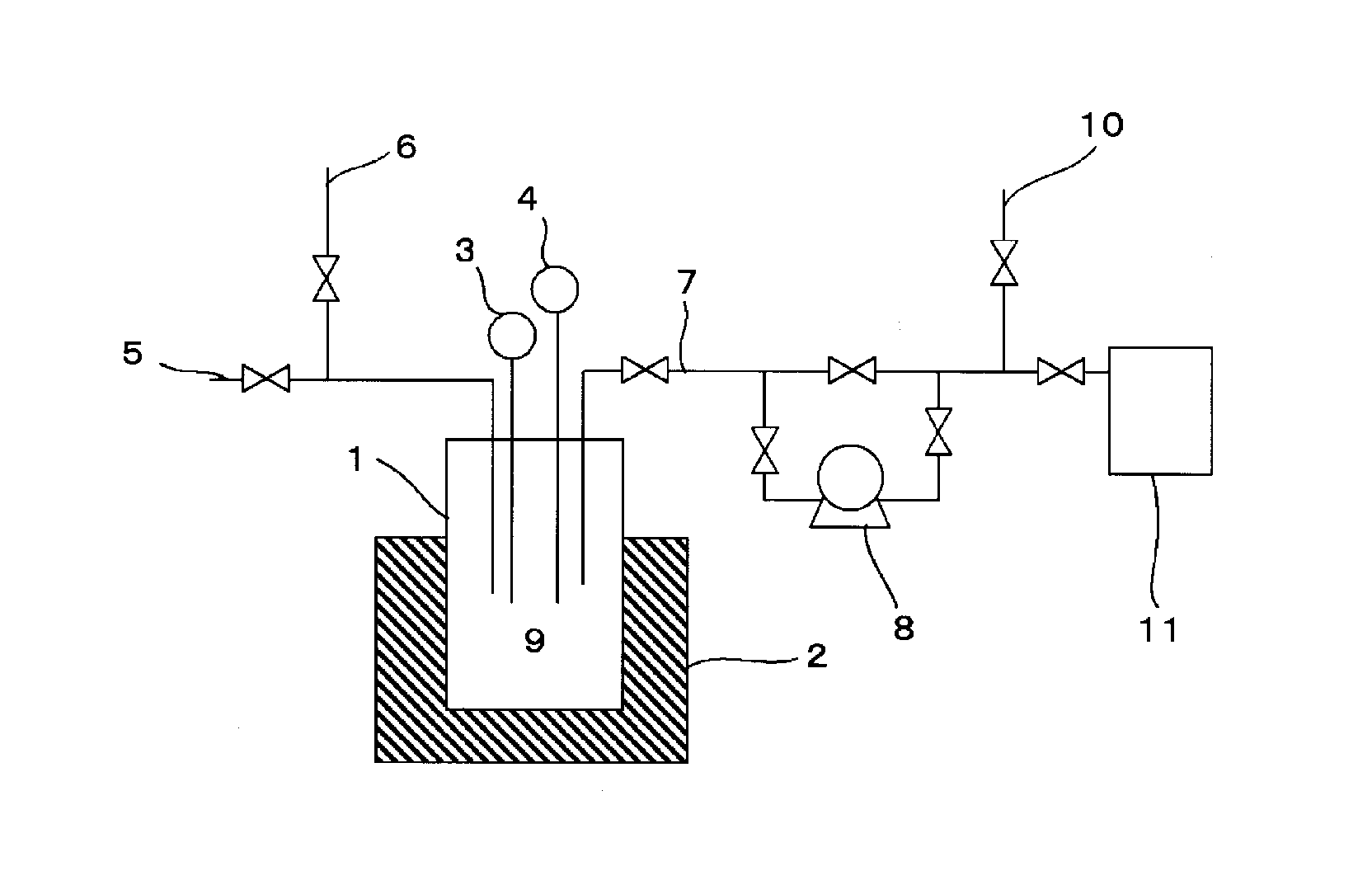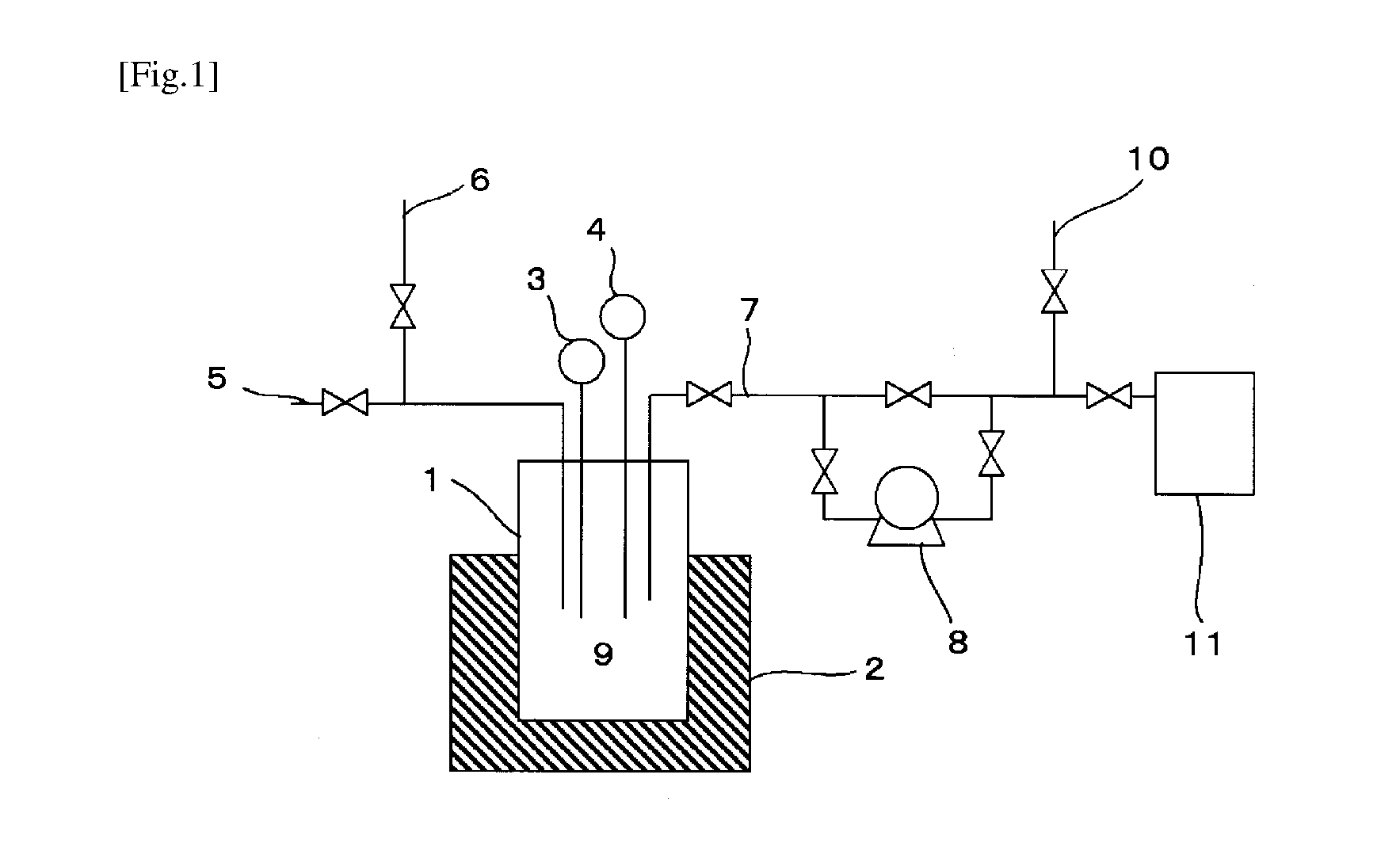Process for purifying phosphorus pentafluoride
a technology of phosphorus pentafluoride and purification process, which is applied in the direction of phosphorus halides/oxyhalides, etc., can solve the problems of industrial disadvantage, difficult separation by ordinary distillation technique, and adverse effects of mixing in a starting material on the performance or safety of the final produ
- Summary
- Abstract
- Description
- Claims
- Application Information
AI Technical Summary
Benefits of technology
Problems solved by technology
Method used
Image
Examples
example 1
[0051]In a 1.5-liter stainless steel-made cylindrical reactor equipped with a thermometer, a pressure gauge, and a heater was put 9.3 g (0.36 mol) of LiF having an average specific surface area of 13.7 m2 / g and heated to 80° C. A mixed gas of 40.4 g (0.32 mol) of PF5, HCl, and HF (PF5 / HCl / HF=1 / 5 / 0.5 by mol; PF5 purity: 15.38 mol %) was introduced into the reactor at 100 kPa·G. After making sure that the PF5 gas reacted with LiF and the inner pressure decreased to 83 kPa·G, the remaining HCl and HF were expelled from the reactor to leave a solid weighing 41.5 g.
[0052]The solid was analyzed to ascertain formation of 38.4 g (0.25 mol) of LiPF6. The acid content in the solid was found to be 1.1 wt % by neutralization titration.
[0053]The resulting LiPF6 (38.4 g, 0.25 mol) was returned to the reactor, and the inner pressure was reduced by a vacuum pump to −70 kPa·G. The LiPF6 in the reactor was heated up to 100° C. to remove HF. The discharged gas was detoxified.
[0054]The LiPF6 in the rea...
example 2
[0056]In a stainless steel-made reaction tube having an inner diameter of 10 mm and equipped with a thermometer, a pressure gauge, and a heater was put 13.0 g (0.50 mol) of LiF having an average specific surface area of 13.7 m2 / g and heated to 80° C. A mixed gas containing 39.6 g (0.31 mol) of PF5, SO3, and HF at a PF5 / SO3 / HF molar ratio of 1 / 0.2 / 0.5 (PF5 purity: 58.82 mol %) was led through the reaction tube at atmospheric pressure to give 52.6 g of a solid, which was analyzed to ascertain formation of 38.2 g (0.25 mol) of LiPF6.
[0057]The resulting LiPF6 (38.2 g, 0.25 mol) was put into the reaction tube, and the inner pressure was reduced by a vacuum pump to −70 kPa·G. The LiPF6 in the reaction tube was heated up to 200° C. The gas discharged by the vacuum pump was analyzed by FT-IR to ascertain formation of PF5. The thus obtained PF5 weighing 28.5 g (0.23 mol) was found to contain a mixture of less than 50 ppm of SO3 and less than 50 ppm of HF. Accordingly, the purity of PF5 was 9...
example 3
[0058]In a stainless steel-made reaction tube having an inner diameter of 10 mm and equipped with a thermometer, a pressure gauge, and a heater was put 10.1 g (0.39 mol) of LiF having an average specific surface area of 13.7 m2 / g and heated to 100° C. A mixed gas containing 45.8 g (0.36 mol) of PF5 and F2 at a PF5 / F2 molar ratio of 1 / 1 (PF5 purity: 50.00 mol %) was led through the reaction tube at atmospheric pressure to give 43.8 g of a solid, which was analyzed to ascertain formation of 40.1 g (0.26 mol) of LiPF6.
[0059]The resulting LiPF6 (40.1 g, 0.26 mol) was put into the reaction tube, and the inner pressure was reduced by a vacuum pump to −70 kPa·G. The LiPF6 in the reaction tube was heated up to 200° C. The gas discharged by the vacuum pump was analyzed by FT-IR to ascertain formation of PF5. The thus obtained PF5 weighing 32.6 g (0.26 mol) was found to contain less than 50 ppm of F2. Accordingly, the purity of PF5 was 99.99 mol %.
PUM
| Property | Measurement | Unit |
|---|---|---|
| specific surface area | aaaaa | aaaaa |
| temperature | aaaaa | aaaaa |
| boiling point | aaaaa | aaaaa |
Abstract
Description
Claims
Application Information
 Login to View More
Login to View More - R&D
- Intellectual Property
- Life Sciences
- Materials
- Tech Scout
- Unparalleled Data Quality
- Higher Quality Content
- 60% Fewer Hallucinations
Browse by: Latest US Patents, China's latest patents, Technical Efficacy Thesaurus, Application Domain, Technology Topic, Popular Technical Reports.
© 2025 PatSnap. All rights reserved.Legal|Privacy policy|Modern Slavery Act Transparency Statement|Sitemap|About US| Contact US: help@patsnap.com


